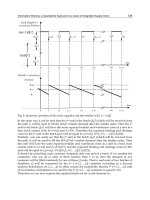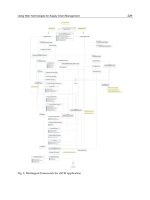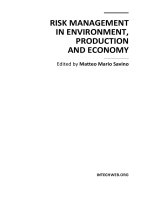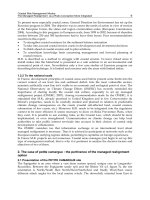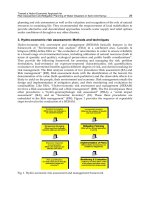Risk Management in Environment Production and Economy Part 8 potx
Bạn đang xem bản rút gọn của tài liệu. Xem và tải ngay bản đầy đủ của tài liệu tại đây (415.57 KB, 20 trang )
A Fuzzy Comprehensive Approach for Risk
Identification and Prioritization Simultaneously in EPC Projects
129
4.1 Fuzzy entropy
The concept of entropy in the context of the information theory was first introduced by
Shannon, and it can be viewed as an order measure in the signal. Shannon entropy,
quantifies the PDF of the signal and it can be computed by:
lo
g
Sh i i
i
H
pp
(7)
where i goes over all amplitude values of the signal and is the
i
p
probability that amplitude
i
a value occurs anywhere in the signal. This concept can be easily extended in a fuzzy
environment.
4.2 Fuzzy VIKOR
The VIKOR method was developed by (Opricovic & Tzeng, 2002). This method is based on
the compromise programming of MCDM. We assume that each alternative is evaluated
according to a separate criterion function; the compromise ranking can be reached by
comparing the measure of closeness to the ideal alternative. The multi-criteria measure for
the compromise ranking is developed from the L
P
-metric used as an aggregating function
for a compromise programming method (Opricovic & Tzeng, 2002; Wu et al., 2010).
Matching MCDM methods with classes of problems will address the correct applications,
and for this reason the VIKOR characteristics are matched with a class of problems as
follows (Opricovic & Tzeng, 2007):
Compromising is acceptable for conflict resolution.
The decision maker (DM) is willing to approve solution that is the closest to the ideal.
There exist a linear relationship between each criterion function and a decision maker’s
utility.
The criteria are conflicting and non-commensurable (different units).
The alternatives are evaluated according to all established criteria (performance matrix).
The DM’s preference is expressed by weights, given or simulated.
The VIKOR method can be started without interactive participation of the DM; but, the
DM is in charge of approving the final solution and his/her preference must be
included.
The proposed compromise solution (one or more) has an advantage rate.
A stability analysis determines the weight stability intervals.
The VIKOR method was introduced as one applicable technique to be implemented within
MCDM problem and it was developed as a multi attribute decision-making method to solve
a discrete decision making problem with non-commensurable (different units) and
conflicting criteria (Opricovic & Tzeng, 2002,2007). This method focuses on ranking and
selecting from a set of alternatives, and determines compromise solution for a problem with
conflicting criteria, which can help the decision makers to reach a final solution. The multi-
criteria measure for compromise ranking is developed from the L
P
-metric used as an
aggregating function in a compromise programming method (Aven & Vinnem, 2005; Aven
et al., 2007).
Assuming that each alternative is evaluated according to each criterion function, the
compromise ranking can be performed by comparing the measure of closeness to the ideal
alternative. The various m alternatives are denoted as
12
,,,
m
A
AA
. For alternative
i
A
, the
Risk Management in Environment, Production and Economy
130
rating of the jth aspect is denoted by
i
j
f
, i.e.
i
j
f
is the value of jth criterion function for the
alternative
i
A
; n is the number of criteria. Development of the VIKOR method is started
with the following form of the L
P
-metric:
1
**
1
/ 1;1,2,,.
p
n
p
pi j ij j j
j
L
ff ff p
im
(8)
In the VIKOR method,
1.i
L (as
i
S ) and
.i
L
(as
i
R ) are used to formulate the ranking
measure. The solution obtained by min
i
S is with a maximum group utility (‘‘majority”
rule), and the solution obtained by min
i
R is with a minimum individual regret of the
‘‘opponent”.
5. Proposed fuzzy comprehensive approach
The proposed fuzzy comprehensive approach is designed in three main sections and
nineteen sub-steps as illustrated in Fig. 3. Project potential risk data gathering is described in
the first section, the fuzzy MCGDM process based on the fuzzy entropy and VIKOR
techniques is explained in details in the second section, and separation of identified and
non-identified risks is discussed in the section three. The fuzzy theory importance in the
proposed fuzzy comprehensive approach is described in following sub-section.
5.1 Fuzzy theory importance in proposed approach
In project risk management, the modelling process of the risks may not be performed
sufficiently and exactly, because the available data and information are vague, inexact,
imprecise and uncertain by nature. The decision-making process dealing with the modelling
of project risks should be based on these uncertain and ill-defined information. To resolve
the vagueness, ambiguity and subjectivity of human judgment, fuzzy sets theory can be
applied to express the linguistic terms in risk decision making process.
The project risk experts or DMs can provide a precise numerical
value, a range of numerical
values, a linguistic term or
a fuzzy number. Consequently, fuzzy linguistic terms are much
easier to be accepted and adopted by the DMs to provide precise numerical judgments
about the criteria of each risk event. Therefore, a linguistic term and a fuzzy
number can be
used in the proposed approach.
Fuzzy membership function: Through the commonly used fuzzy numbers, triangular fuzzy
numbers are likely to be the most
adoptive ones for their simplicity in modelling and
interpreting. We figure out that a
triangular fuzzy number can adequately represent the
seven level fuzzy linguistic variables and thus it is used for the
analysis hereafter. Table 1
illustrates the linguistic terms
defined for the criteria of project risk event in this paper.
Moreover, the fuzzy membership functions are illustrated in
Fig. 4.
5.2 Steps of the proposed fuzzy comprehensive approach
Section 1: Project potential risk data collection
Step 1.
In this step, project potential risks are gathered by applying historical information,
lessons learned and NGT method in order to establish the potential risk breakdown
A Fuzzy Comprehensive Approach for Risk
Identification and Prioritization Simultaneously in EPC Projects
131
structure (PRBS). Many approaches have been suggested in the literature for
classifying risks (Chapman & Ward, 2004; Perry & Hayes, 1985; Shen et al., 2001). In
this paper, a new practical approach based on Makui et al. (2010) is considered for
classifying risks. Potential risks are grouped in adhere to the project work break
down structure (WBS) in order to study potential risks in different levels of project
and scope of work.
Fig. 3. Proposed fuzzy comprehensive approach for the risk identification and prioritization
simultaneously
Risk Management in Environment, Production and Economy
132
Description Scale Measure
Almost Certain AC (0, 0, 0.1)
Highly Likely HL (0, 0.1, 0.3)
Likely L (0.1, 0.3, 0.5)
Possible P (0.3, 0.5, 0.7)
Unlikely UL (0.5, 0.7, 0.9)
Rare R (0.7, 0.9, 1)
Non-Identified NI (0.9, 1, 1)
Table 1. Linguistic variables for the importance weight of each criterion.
Fig. 4. Fuzzy membership triangular functions.
We propose a solution for structuring the risk management problem in order to adopt the
full hierarchical approach used in the WBS, which as many levels as are required to provide
the necessary understanding of risk exposure to allow effective management. Such a
hierarchical structure of risk source should be known as a PRBS based on WBS. The
proposed PRBS is defined here as a source-oriented grouping of project potential risks that
organize and defines the total risk exposure of the project based on the WBS. Each
descending level represents an increasingly detailed definition of sources of potential risk to
the project based on the WBS.
Section 2: Fuzzy group decision-making process
This study aims to identify and prioritize project risks concurrently. Fuzzy entropy and
fuzzy VIKOR techniques is used to identify risks from PRBS and prioritize them in the same
time in a fuzzy environment.
Step 2. The lowest level of the PRBS constructs the alternatives of the fuzzy decision
matrix.
A Fuzzy Comprehensive Approach for Risk
Identification and Prioritization Simultaneously in EPC Projects
133
Step 3. Determine risk identification criteria as follows:
C
1
: Existing and observing in other similar projects.
C
2
: Disability to transfer the potential risk to client or employer.
C
3
: Contract's disability to clarify the potential risk.
Step 4. Determine risk analysis criteria as below (Makui et al., 2010):
C
4
: Probability, C
5
: Time impact, C
6
: Cost impact, C
7
: Performance impact
Step 5. The DMs in the project:
The selection of experts for answering potential risk against criteria is very critical
and it should be selected from project stakeholders.
Step 6. In order to take precise advantages form the fuzzy VIKOR method, some
assumptions can be considered:
a.
Criteria are the same for all DMs.
b.
Criteria may have different weights but criteria's weights are the same for all DMs.
c.
DMs have different weights.
Step 7. Construct fuzzy decision matrix D,
1,2, ,
p
k for each of the experts. The
structure of the fuzzy matrix can be depicted by:
12
1
11 12 1
1
2
21 22 2
2
()
12
.
.
jn
pp p p
n
j
pp p p
n
j
p
pp p p
i
i i ij in
m
c c c c
PR
x x x x
PR
x x x x
.
. . .
DM
PR
x x x x
.
PR
12
pp p
p
mn
mm
mj
. .
x x x x
(9)
where
i
PR denotes the ith potential risk,
j
C
; represents the jth criterion or attribute,
1,2, ,jm (which are identified in Steps 3 and 4); with qualitative data. The element of
p
DM is
p
i
j
x
, which indicates the perform rating of alternative
i
PR with respect to
criterion
j
C
; by DM
1,2, ,
p
k .
Please note that there should be k fuzzy decision matrix for the k members of a group.
Observe that the DMs can also set the outcomes of qualitative or intangible criterion for each
alternative as discrete values, or other linguistics values will be placed in the above decision
matrix.
Step 8. Construct the fuzzy normalized decision matrix R
, by each DM for n criteria. The
normalized value
p
i
j
r
in the decision matrix
p
R
is calculated by Eq. (5); (all criteria
are considered as benefit).
Risk Management in Environment, Production and Economy
134
Step 9.
Construct the group decision matrix G
as follows:
12
1
11 12 1 1
2
21 22 2 2
12
.
jn
j
n
j
n
i
i i ij in
m
c c c c
PR
g g g g
PR
g g g g
.
. . .
G
PR
g
g
g
g
.
.
PR
12
i i ij in
.
g g g g
(10)
The grouping value for criterion
j can be as follows:
1
; 1,2, , , 1, 2, ,
k
p
p
ij D
ij
p
gWri mj n
(11)
p
D
W
is the weight of each DM, where we have:
1
1
k
p
D
p
W
(12)
Step 10. Change the evaluation index from different measurement to the same
measurement.
1
n
i
j
i
j
i
j
j
p
xx
(13)
Step 11. Calculate entropy of every index weight
1
ln
n
ii
j
i
j
j
ek
pp
(14)
where
0, 1 ln , 0
i
kk ne
.
Step 12.
Define the difference coefficient 1
ii
ge
, the bigger the
i
g
, the more important the
index is. Identifying the indexes' value and applying entropy weight method.
1
1,2, ,
m
ii i
i
wg g i m
(15)
Weight vector is
112
,,,
m
www w
.
A Fuzzy Comprehensive Approach for Risk
Identification and Prioritization Simultaneously in EPC Projects
135
There are many methods that can be employed to determine weights (Kuo et al., 2007; Wang
et al., 2007). In this paper, the weights provided by the fuzzy entropy technique are used.
Step 13.
Determine the best
*
j
f
and the worst
j
f
values of all criterion functions
1,2, ,jn .If the jth function represents a benefit, then we have:
*
max
ii
j
j
ff
(16)
and
min
ii
j
j
ff
(17)
Step 14. Compute the values
i
S and
i
R ; 1,2, ,im
, by these relations:
**
1,
1
,
m
ii jjijjj
j
SL wf f f f
(18)
**
,
max ,
ii jjijjj
j
RL wf f f f
(19)
where
j
w are the weights of criteria, expressing their relative importance.
Step 15. Compute the values
i
Q
; 1,2, ,im
, by the following relation:
** * *
1
ii i
QvSS SS vRR RR
(20)
Where
*
min , max
ii
i
i
SSS S
(21)
*
min , max
ii
i
i
RRR R
(22)
v is introduced as weight of the strategy of “the majority of criteria” (or “the maximum
group utility”), here suppose that v = 0.5.
Step 16. Rank the alternatives, sorting by the values S, R and Q in decreasing order. The
results are three ranking lists.
Step 17. Propose as a compromise solution the alternative A
, which is ranked the best by
the measure Q (Minimum) if the following two conditions are satisfied:
C1. Acceptable advantage:
QA QA DQ
where
A
is the alternative with the second position in the ranking list by Q;
11DQ m; m is the number of alternatives.
C2. Acceptable stability in decision making:
Risk Management in Environment, Production and Economy
136
Alternative A
should be also the best ranked by S or/and R. This compromise solution is
stable within a decision-making process, which can be “voting by majority rule” (when
0.5v is needed), or ‘‘by consensus” 0.5v
, or ‘‘with veto” ( 0.5v
). Here, v is the weight
of the decision-making strategy “the majority of criteria” (or “the maximum group utility”).
If one of the conditions is not satisfied, then a set of compromise solutions is proposed,
which consists of:
Alternatives A
and A
if only condition C2 is not satisfied, or
Alternatives
()
,,,
M
AA A
if condition C1 is not satisfied;
()
M
A
is determined by the
relation
M
QA QA DQ
for maximum M (the positions of these alternatives are
“in closeness”).
The best alternative, ranked by Q, is the one with the minimum value of Q. The main
ranking result is the compromise ranking list of alternatives, and the compromise solution
with the “advantage rate”. VIKOR is an effective tool in MCDM, particularly in a situation
where the DM is not able, or does not know to express his/her preference at the beginning
of the system design. The obtained compromise solution can be accepted by the DMs
because it provides a maximum “group utility” (represented by min S) of the “majority”,
and a minimum of the “individual regret” (represented by min R) of the “opponent”. The
compromise solutions can be the basis for negotiations, involving the DM preference by
criteria weights.
Section 3: Separation of identified and non-identified risks
Step 18.
In this step, one threshold can be determined in order to separate identified risks
from potential risks, moreover, some ranges could be developed to assess the
identified risks into “Almost certain risks” up to “Rare risks”, as shown in Fig. 5.
Step 19. Classify identified risks (with analysis) and non-identified risks.
Fig. 5. Identifying and analysing project risks concurrently by defining appropriate
thresholds.
A Fuzzy Comprehensive Approach for Risk
Identification and Prioritization Simultaneously in EPC Projects
137
6. Application to an EPC project
In this section, the proposed comprehensive approach is applied in the engineering phase of
an EPC project. A project, as defined in the field of project management, consists of a
temporary endeavor undertaken to create a unique product, service or result (Cooper et al.,
2005). Project management tries to gain control over project's variables, such as risk. Thus, a
risk analysis is essential for all phases of projects particularly engineering phase because this
phase is a commencement phase of project. Project promoters depend upon several project
partners (e.g., consultants, architects and contractors) to convert their plans into reality.
Among the project partners, EPC contractors play a crucial role in the actual implementation
of projects. Depending upon the size of a project, an EPC contractor might execute the same
solely or break the project into different categories and delegate it to a number of sub-
contractors.
Easy to manage by client, reduction of project time and cost, output guarantees, shortened
project life cycle, improving contractors' abilities and financers' interests are the most
advantages of EPC contracts. However, increasing contractor risk to perform the job, under-
estimating and quality of work are the major disadvantages of EPC contracts. Most
engineering contracts can fall into four major scopes of services:
Basic Engineering (BE)
Front End Engineering Design (FEED)
Detailed Engineering (DE)
Field Engineering (FE)
The main deliverable of a "Conceptual Design", which elaborates project feasibility, is the
Master Development Plan (MDP). A basic designer further develops the MDP and creates
the necessary integrity in each functional department to aim the proper design for having
such industrial complex. The
FEED is the extension of BE in order to create Material
Requisition (MR) for Long Lead Items (LLI) in the project procurement phase. The BE or
FEED will be the input to start the DE. Huge amount of man-hours are
spent in comparison
to the BE and FEED. The DE produces required documents for the project procurement and
construction phases. Although using powerful tools, such as modeling software, helps the
designer to minimize construction problems; however, still some problems exist that need
and aggressive solutions during construction at project's site. Nowadays companies try to
mobilize a technical crew at their site to solve and mitigate such obstacles during
construction. These people have both good knowledge of engineering and construction
experience. This step mainly is called the FE.
DMs' weights are calculated by using the entropy technique and results as shown in Table 2.
Criteria Weight Decision Maker Weight
C
1
(0.15,0.20,0.30)
C
2
(0,0.10,0.15) DM
1
(0.30,0.45, 0.60)
C
3
(0,0.10,0.15)
C
4
(0.15,0.20,0.30) DM
2
(0.20,0.35,0.50)
C
5
(0.10,0.15,0.20)
C
6
(0.10,0.15,0.20) DM
3
(0.05,0.15,0.30)
C
7
(0,0.10,0.15)
Table 2. Weights of criteria and decision makers.
Risk Management in Environment, Production and Economy
138
Potential risks can be classified into two groups: 1) identified risks and 2) non-identified
risks. Moreover identified risks can be classified into several analysis levels. These can be
taken by defining appropriate thresholds as determined in Table 3.
The criteria of identified risks are rated on a six-point descriptive scale in terms of their
crucial roles in identifying risks. Table 4 shows a suitable scale for identifying risks in EPC
projects according to Makui et al. (2010).
Identification & analysis phases concurrently
i
Q
Identified risks Almost certain risks > 0.75
Highly likely risks 0.60-0.75
Likely risks 0.45-0.60
Possible risks 0.40-0.45
Unlikely risks 0.35-0.40
Rare risks 0.30-0.35
Non-identified risks < 0.30
Table 3. Thresholds of identification and prioritization phases.
Description Scale Existing and observing in
other similar or related
projects (C
1
)
Disability to transfer the
potential risk to client or
employer (C
2
)
Contract disability to
clarify the potential
risk (C
3
)
Almost Certain AC > 8 cases out of 10 similar
projects
Contract disability is almost
certain to transfer the
potential risk to client or
employer.
Contract disability for
clarifying the
potential risk is
almost certain.
Highly Likely HL 6-8 cases out of 10 similar
projects
Contract disability is highly
likely to transfer the
potential risk to client or
employer.
Contract disability for
clarifying the
potential risk is
highly likely.
Likely L 4-6 cases out of 10 similar
projects
Contract disability is likely
to transfer the potential risk
to client or emplo
y
er.
Contract disability for
clarifying the
potential risk is likel
y
.
Possible P 2-4 cases out of 10 similar
projects
Contract disability is
possible to transfer the
potential risk to client or
employer.
Contract disability for
clarifying the
potential risk is
possible.
Unlikely UL 1-2 cases out of 10 similar
projects
Contract disability is
unlikely to transfer the
potential risk to client or
employer.
Contract disability for
clarifying the
potential risk is
unlikely.
Rare R Nothing
Contract disability is rare to
transfer the potential risk to
client or emplo
y
er.
Contract disability for
clarifying the
potential risk is rare.
Table 4. Measure of project risk identification criteria used within the contents of the EPC
project.
A Fuzzy Comprehensive Approach for Risk
Identification and Prioritization Simultaneously in EPC Projects
139
Table 5 shows an extended probability and impact scales developed for a multi-purpose set
of the analysis. They are rated in terms of weekly occurrence and potential impact on the
criteria on a six-point descriptive scale for probability and impact criteria, respectively. The
scale in Table 5 is used successfully in the risk analysis for EPC projects. However, it can be
adapted easily to smaller than less complex projects.
By considering above information (Tables 1 to 5) and fuzzy group decision-making
techniques based on the fuzzy entropy and VIKOR (Steps 6 to 17), the computational results
are shown in Table 6.
Description Scale Probability (C
4
) Time (C
5
) Cost (C
6
) Performance (C
7
)
Almost Certain AC > 0.9 > 20 weeks > $50m Key performance criteria
cannot be achieved
Highly Likely HL 0.7-0.9 15-20 weeks $30m-$50m Very Significant reduction in
performance
Likely L 0.5-0.7 10-15 weeks $10m-$30m Significant reduction in
performance
Possible P 0.3-0.5 5-10 weeks $1m-$10m Some reduction in performance
Unlikely UL 0.1-0.3 1-5 weeks $0.1m-$1m Small reduction in performance
Rare R < 0.1 < 1 weeks < $0.1m Minimal or unimportant
performance impacts
Table 5. Measure of project risk analysis criteria used within the contents of the EPC project.
7. Discussion of results
In this paper, we identify and prioritize risks concurrently by using the fuzzy entropy and
VIKOR techniques in the EPC project. The inference of the results is applicably feasible,
appealing and interesting in the EPC project. We also classify potential risks in accordance
with the work breakdown structure (WBS) in three levels and after applying the proposed
fuzzy comprehensive approach, we calculate portion of each WBS levels from identified
risks as shown in Fig. 6. For instance, 31.60% of identified and prioritized risks belong to the
construction part
.
The computational results show that management's risks are in the first priority for
responding and further actions. Other ranks are illustrated in Table 7. Furthermore, by
considering the defined thresholds in Table 3 and the obtained results from Table 4, the
results of the EPC project risk identification and risk prioritization are classified in Table 6.
In addition, each portion is illustrated in Fig. 7. As it is evident 10.53% of risks are evaluated
as possible risks and 5.26% of risks are evaluated as rare risks. Their ranks are shown in
Table 8.
Risk Management in Environment, Production and Economy
140
Fig. 6. Each WBS portion from identified risks in the EPC project.
Fuzzy group weighted matrix
WBS Potential risk code Potential risk description
i
Q
Engineering
(E)
ENG-01-10 Design failures 0.338
ENG-02-11 Change in project scope of work 0.432
ENG-03-12 Data transition from basic to detail
design
0.462
ENG-04-13 Lack of resources 0.392
ENG-05-14 Inadequate design quality 0.439
Procurement
(P)
PRO-01-15 International relations 0.919
PRO-02-16 Ambiguity in project cash injection 0.540
PRO-03-17 Inappropriate vendor list 0.362
PRO-04-18 Delay in purchasing 0.504
PRO-05-19 Imperfect data transmission to
vendors
0.291
PRO-06-20 Inspection and forwarding problems 0.278
Construction
(C)
CON-01-21 Critical weather conditions 0.662
CON-02-22 HSE matters 0.707
CON-03-23 Workers riots 0.369
CON-04-24 Poor team communication 0.099
CON-05-25 Contagious diseases 0.393
CON-06-26 Subcontractor interfaces 0.549
CON-07-27 Inadequate QA/QC inspections and
audits
0.233
CON-08-28 Delay in equipment delivery to site 0.716
Table 6. Fuzzy group decision matrix and ranking outcome for the EPC project risks.
A Fuzzy Comprehensive Approach for Risk
Identification and Prioritization Simultaneously in EPC Projects
141
WBS
Portion of
i
Q
Rank
Engineering (E) 26.30% 2
Procurement (P) 21.00% 3
Construction (C) 31.60% 1
Table 7. WBS leveling based on the portion of Q
i
.
Identified and analysis levels
Portion of
i
Q
Rank
Almost certain risks 5.26% 4
Highly likely risks 15.79% 2
Likely risks 21.05% 1
Possible risks 10.53% 3
unlikely risks 21.05% 1
Rare risks 5.26% 4
Non-identified risks 21.05% 1
Table 8. Ranking based on the portion of Q
i
.
Fig. 7. Portion of each threshold from identified and non-identified project risks.
Risk Management in Environment, Production and Economy
142
8. Conclusion
Decisions are made today in increasingly complex environments. In more and more cases,
the use of experts or decision makers in various fields is necessary. In many of such
decision-making settings, the theory of group decision making can play crucial role. Group
decision making in a fuzzy environment can overcome this difficulty as well. This paper has
extended a new comprehensive approach for identifying and prioritizing risks of
Engineering, Procurement and Construction (EPC) projects by using the Multiple Criteria
Group Decision Making (MCGDM) in a fuzzy environment based on the fuzzy entropy and
VIKOR techniques. In addition, this study has explored the use of two well-known fuzzy
decision-making techniques for solving risk identification and prioritization concurrently.
The fuzzy entropy has been utilized to obtain the weights of criteria, and the fuzzy VIKOR
has been also used for ranking the potential risks as viable techniques for the problem. The
fuzzy VIKOR is suitable for the use of precise performance ratings. When the performance
ratings are vague and inaccurate, then the fuzzy MCDGM is the preferred approach. New
criteria have been considered
for risk management in EPC projects, in which they cover risk
identification and risk prioritization concurrently. Then, a new method has been applied for
classifying potential risks as PRBS. Furthermore, the techniques and experiences learned
from the study can be valuable to future strategic planning for the company. The obtained
results from the case study in the EPC project in Iran have shown that the proposed fuzzy
comprehensive approach has been viable in solving the proposed risk identification and
prioritization problems in EPC projects.
9. Acknowledgment
The authors would like to thank the EPC project's experts for their very valuable and helpful
contributions on data collection for this study. The authors also thank Mr. S.M.H. Mojtahedi
from School of Civil Engineering at the University of Sydney in Australia for his helpful
comments and suggestions, which improve the primary version of the study.
10. References
Al-Bahar J.F. & Crandell, K.C. (1990). Systematic risk management approach for
construction projects. Journal of Construction Engineering and Management, Vol. 116,
No. 3, pp. 533-556.
Alborzi, S.; Aminian, A.; Mojtahedi, S.M.H. & Mousavi, S.M. (2008). An analysis of project
risks using the non-parametric Bootstrap technique. Proc. of the IEEE International
Conference on Industrial Engineering and Engineering Management, Singapore, 8-11
December 2008, pp. 1295-1299.
Aven, T. & Vinnem J.E. (2005). On the use of risk acceptance criteria in the offshore oil and
gas industry. Reliability Engineering and System Safety, Vol.90 , pp. 15–24.
Aven, T.; Vinnem J.E. & Wiencke, H.S. (2007). A decision framework for risk management
with application to the offshore oil and gas industry. Reliability Engineering and
System Safety, Vol.92, pp. 433–448.
Carlsson, C. (1982). Tackling an MCDM-problem with the help of some results from fuzzy
set theory. European Journal of Operational Research, Vol.10, No.3, pp. 270–281.
A Fuzzy Comprehensive Approach for Risk
Identification and Prioritization Simultaneously in EPC Projects
143
Carr, V. & Tah, J.H.M. (2001). A fuzzy approach to construction project risk assessment and
analysis: construction project risk management system. Advances in Engineering
Software, Vol.32, No.10-11, pp. 847–857.
Chapman, C. & Ward, S. (2004). Project risk management: processes, techniques and insights,
Second ed., John Wiley and Sons Ltd.
Chapman, R.J. (1998). The effectiveness of working group risk identification and
assessment techniques. International Journal of Project Management, Vol.16, pp.
333-343.
Chapman, R.J. (2001). The controlling influences on effective risk identification and
assessment for construction design management. International Journal of Project
Management, Vol. 19, pp. 147–160.
Chen, C.T. (2000). Extensions of the TOPSIS for group decision-making under fuzzy
environment. Fuzzy Sets and Systems, Vol.114, pp. 1-9.
Chen, S.J. & Hwang, C.L. (1992). Fuzzy multiple attribute decision making methods and
applications, Springer, Berlin.
Chen, S.M. (1997). A new method for tool steel materials selection under fuzzy environment.
Fuzzy Sets and Systems, Vol.92, pp. 265–274.
Chun M. & Ahn, K. (1992). Assessment of the potential application of fuzzy set theory to
accident progression event trees with phenomenological uncertainties. Reliability
Engineering and System Safety, Vol.37, No.3, pp. 237
-252.
Cooper, D.F.; Grey, S.; Raymond, G. & Walker P. (2005). Project risk management guidelines:
managing risk in large projects and complex procurements, John Wiley & Sons,
Chichester, England.
Dikmen, I.; Birgonul, M.T. & Han, S. (2007). Using fuzzy risk assessment to rate cost overrun
risk in international construction projects. International Journal of Project
Management, Vol.25, pp. 494–505.
Dubois, D. & Prade, H. (1980). Fuzzy sets and systems: theory and application, Academic Press,
New York.
Ebrahimnejad, S.; Mousavi, S.M. & Mojtahedi, S.M.H. (2008a). A fuzzy BOT project risk
evaluation model in iranian power plant industry, The 5th of IEEE International
Conference on Industrial Engineering and Engineering Management, Singapore.
Ebrahimnejad, S.; Mousavi, S.M. & Mojtahedi, S.M.H. (2008b). A model for risk evaluation
in construction projects based on fuzzy MADM, Proceedings of 4th IEEE
International Conferences on Management of Innovation & Technology, Thailand, pp.
305–310,.
Ebrahimnejad, S.; Mousavi, S.M. & Mojtahedi, S.M.H. (2009). A fuzzy decision making
model for risk ranking with application to the onshore gas refinery. International
Journal of Business Continuity and Risk Management, Vol.1, No.1, pp. 38–66.
Ebrahimnejad, S.; Mousavi, S.M. & Seyrafianpour, H. (2010). Risk identification and
assessment for build-operate-transfer projects: a fuzzy multi attribute decision
making model. Expert Systems with Applications, Vol.37, No.1, pp. 575–586.
Flanagan, R. & Norman, G. (1993). Risk management and construction, Blackwell Science Pty
Ltd,Victoria, Australia.
Risk Management in Environment, Production and Economy
144
Hashemi, H.; Mousavi, S.M. & Mojtahedi, S.M.H. (2011). Bootstrap technique for risk
analysis with interval numbers in bridge construction projects, Journal of
Construction Engineering and Management, doi:10.1061/(ASCE)CO.1943-862.0000344.
Heydar, M.; Tavakkoli-Moghaddam, R
.; Mousavi, S.M. & Mojtahedi, S.M.H. (2008).
Fuzzy multi-criteria decision making method for temporary storage design in
industrial plants. Proc. of the IEEE International Conference on Industrial
Engineering and Engineering Management, Singapore, 8-11 December 2008, pp.
1154-1158.
Hillson D. (2002). Extending the risk process to manage opportunities. International Journal of
Project Management, Vol.20, No.3, pp. 235–240.
Kangari, R. (1998). Construction risk management. Civil Engineering and System, Vol. 5, pp.
114
-120.
Kauffman, A. & Gupta, M.M. (1991). Introduction to fuzzy arithmetic: Theory and application,
Van Nostrand Reinhold, New York.
Kuo, M.S.; Tzeng, G.H. & Huang, W.C. (2007). Group decision-making based on concepts of
ideal and anti-ideal points in a fuzzy environment. Mathematical and Computer
Modelling, Vol.45, pp. 324–339.
Makui A.; Mojtahedi, S.M.H. & Mousavi, S.M. (2007). Introducing new and practical risk
identification methods in mega projects. In Proc. of the First International Congress on
Risk Management, Iran, pp. 107–124.
Makui, A.; Mojtahedi, S.M.H. & Mousavi, S.M. (2010). Project risk identification and
analysis based on group decision making methodology in a fuzzy environment.
International Journal of Management Science and Engineering Management, Vol.5,
No.2, pp. 108–118.
Malekly, H.; Mousavi, S.M. & Hashemi, H. (2010). A fuzzy integrated methodology for
evaluating conceptual bridge design. Expert Systems With Applications, Vol.37, pp.
4910–4920.
Mojtahedi S.M.H.; Mousavi, S.M & Aminian, A. (2009). A non-parametric statistical
approach for analyzing risk factor data in risk management process. Journal of
Appled Science, Vol.9, No.1, pp. 113–120.
Mojtahedi, S.M.H.; Mousavi, S.M. & Makui, A. (2008). Risk identification and analysis
concurrently: group decision making approach. Proceedings of 4th IEEE
International Conferences on Management of Innovation & Technology, pp. 299–304,
Thailand.
Mojtahedi, S.M.H.; Mousavi, S.M. & Makui, A. (2010). Project risk identification and
assessment simultaneously using multi-attribute group decision making technique.
Safety Science, Vol.48, No.4, pp. 499–507.
Mousavi, S.M.; Malekly, H.; Hashemi, H. & Mojtahedi, S.M.H. (2008). A two phase fuzzy
decision
making methodology for bridge scheme selection", Proceedings of the IEEE
International Conference on Industrial Engineering and Engineering Management,
Singapore, 8-11 December 2008, pp. 415-419.
Mousavi, S.M.; Tavakkoli-Moghaddam, R
.; Azaron, A.; Mojtahedi, S.M.H. & Hashemi H.
(2011). Risk assessment for highway projects using jackknife technique. Expert
Systems With Applications,Vol.38, No.5, pp. 5514-5524.
A Fuzzy Comprehensive Approach for Risk
Identification and Prioritization Simultaneously in EPC Projects
145
Opricovic, S. & Tzeng, G.H. (2002). Compromise solution by MCDM methods: A
comparative analysis of VIKOR and TOPSIS. European Journal of Operational
Research, Vol.156, pp. 445–455.
Opricovic, S. & Tzeng, G.H. (2007). Extended VIKOR method in comparison with out
ranking methods, European Journal of Operational Research, Vol.178, pp.514–529.
Peak, J.H.; Lee, Y.W. & Ock, J.H. (1993). Pricing construction risk
-fuzzy set application.
Journal of Construction Engineering and Management, Vol.119, No.4, pp. 743
-756.
Perry, J.H. & Hayes, R.W. (1985). Risk and its management in construction projects. in Proc.
of the Institution of Civil Engineering, Part I, pp. 499–521.
Raftery J. (1999). Risk analysis in project management, E & FN Spon.
Ross, T. & Donald, S. (1995). A fuzzy multi-objective approach to risk management. Proc. of
the Second Congress held in Conjunction with A/E/C Systems, ASCE, New York, Vol. 2,
pp. 1400
-1403,.
Ross, T. & Donald, S. (1996). A fuzzy logic paradigm for fault trees and event trees in risk
assessment. Proc. of the Third Congress, ASCE, New York, pp. 369
-375.
Shen, L.Y.; Wu, G.W.C. & Ng, C.S.K. (2001). Risk assessment for construction joint ventures
in China. Journal of Construction Engineering and Management, Vol.127, No.1, pp. 76–
81.
Tah, J.H.M.; Thorpe, A. & McCaffer, R. (1993). Contractor project risks contingency
allocation using linguistic approximation. Computer Systems Engineering, Vol.4,
No.2, pp. 281
-293.
Tavakkoli-Moghaddam, R.; Mojtahedi, S.M.H.; Mousavi, S.M. & Aminian A. (2009). A
jackknife technique to estimate the standard deviation in a project risk severity
data analysis. in Proc IEEE Int Conf Comput Ind Eng (CIE39), France, pp. 1337–
1341.
Thevendran, V. & Mawdesley, M.J. (2004). Perception of human risk factors in construction
projects: an exploratory study. International Journal of Project Management, Vol. 22,
pp. 131–137.
Thomas E.U. (2003). Programming and scheduling techniques, UNSW Press.
Tsao, C.T. (2003). Evaluating investment values of stocks using a fuzzy TOPSIS approach.
Journal of Information & Optimization Sciences, Vol.24, No.2, pp. 373–396.
Wang, Y.M.; Luo, Y. & Hua, Z.S. (2007). A note on group decision-making based on concepts
of ideal and anti-ideal points in a fuzzy environment. Mathematical and Computer
Modelling, Vol.46, pp. 1256–1264
Wirba, E.N.; Tah, J.H.M. & Howes, R. (1996). Risk interdependencies and natural language
computations. Engineering, Construction, and Architectural Management, Vol.3, No.4,
pp. 251–269.
Wu, H.Y.; Chen J.K. & Chen I.S. (2010). Innovation capital indicator assessment of
Taiwanese Universities: A hybrid fuzzy model application. Expert Systems with
Applications Vol.37, No.2, pp. 514–529.
Zadeh, L.A. (1975). The concept of a linguistic variable and its application approximate
reasoning. Information Sciences, Vol.8, No.3, pp. 199–249.
Risk Management in Environment, Production and Economy
146
Zeng, J.; An, M. & Smith, N.J. (2007). Application of a fuzzy based decision making
methodology to construction project risk assessment. International Journal of Project
Management, Vol.25, pp. 589–600.
Zimmermann, H.J. (1996). Fuzzy Set Theory and its Applications. second ed., Kluwer Academic
Publishers.
Part 3
Economy


